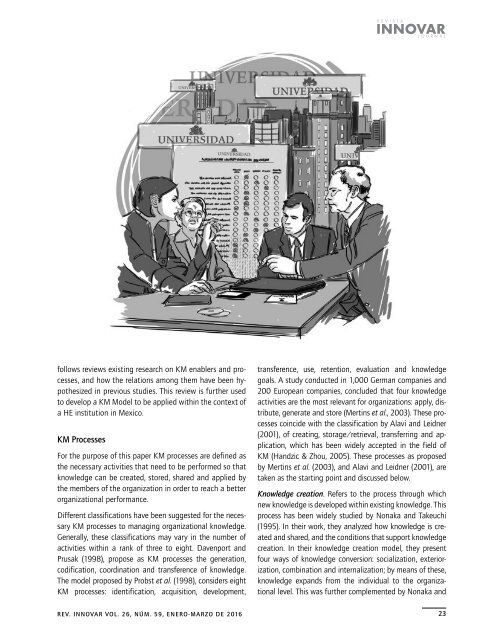Enero-marzo
v26n59
v26n59
You also want an ePaper? Increase the reach of your titles
YUMPU automatically turns print PDFs into web optimized ePapers that Google loves.
REVISTA<br />
INNOVAR<br />
JOURNAL<br />
follows reviews existing research on KM enablers and processes,<br />
and how the relations among them have been hypothesized<br />
in previous studies. This review is further used<br />
to develop a KM Model to be applied within the context of<br />
a HE institution in Mexico.<br />
KM Processes<br />
For the purpose of this paper KM processes are defined as<br />
the necessary activities that need to be performed so that<br />
knowledge can be created, stored, shared and applied by<br />
the members of the organization in order to reach a better<br />
organizational performance.<br />
Different classifications have been suggested for the necessary<br />
KM processes to managing organizational knowledge.<br />
Generally, these classifications may vary in the number of<br />
activities within a rank of three to eight. Davenport and<br />
Prusak (1998), propose as KM processes the generation,<br />
codification, coordination and transference of knowledge.<br />
The model proposed by Probst et al. (1998), considers eight<br />
KM processes: identification, acquisition, development,<br />
REV. INNOVAR VOL. 26, NÚM. 59, ENERO-MARZO DE 2016<br />
transference, use, retention, evaluation and knowledge<br />
goals. A study conducted in 1,000 German companies and<br />
200 European companies, concluded that four knowledge<br />
activities are the most relevant for organizations: apply, distribute,<br />
generate and store (Mertins et al., 2003). These processes<br />
coincide with the classification by Alavi and Leidner<br />
(2001), of creating, storage/retrieval, transferring and application,<br />
which has been widely accepted in the field of<br />
KM (Handzic & Zhou, 2005). These processes as proposed<br />
by Mertins et al. (2003), and Alavi and Leidner (2001), are<br />
taken as the starting point and discussed below.<br />
Knowledge creation. Refers to the process through which<br />
new knowledge is developed within existing knowledge. This<br />
process has been widely studied by Nonaka and Takeuchi<br />
(1995). In their work, they analyzed how knowledge is created<br />
and shared, and the conditions that support knowledge<br />
creation. In their knowledge creation model, they present<br />
four ways of knowledge conversion: socialization, exteriorization,<br />
combination and internalization; by means of these,<br />
knowledge expands from the individual to the organizational<br />
level. This was further complemented by Nonaka and<br />
23


